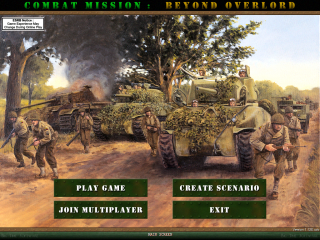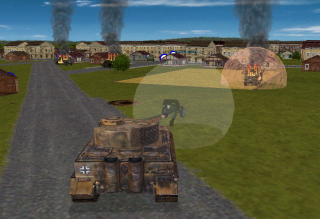Overview
 Combat Mission: Beyond Overlord's Main Menu
Combat Mission: Beyond Overlord's Main MenuDeveloped by Big Time Software and published by Battlefront.com, Combat Mission: Beyond Overlord is a tactical World War II combat simulation that was released in June of 2000. With a specific focus on the north-western part of the war's European theatre, Beyond Overlord provides a variety of combat scenarios of varying scale and composition which typically represent either a known historical engagement or an encounter based on a compelling fictional or hypothetical event. Battles in Combat Mission place a heavy emphasis on realism, with systems in place to simulate everything from the fatigue, stress, and experience levels of individual units, to projected enemy locations based on sound cues. Unlike the more traditional wargames which dominated at the time, Beyond Overlord abandons hexagon-based movement and strict turn-based "I go, you go" gameplay in favor of a full range of movement and turns which are followed by simultaneous action on both sides. These changes were made, according to the designers, to reduce the "gamey" nature of some of the mechanics which were commonly accepted in older computer wargames, which were holdovers from their tabletop predecessors. Beyond Overlord operates on the "we go" principle, and the resulting product is intended to be a more realistic simulation by merging the best elements of both real-time and turn-based games, allowing both sides to move and attack in tandem while still allowing players to plot their movements without the pressures of an advancing army.
The success of Beyond Overlord would be followed by Barbarossa to Berlin in 2002 and Afrika Korps in 2003, collectively regarded as the original Combat Mission trilogy, and together they cover all of the major land-based theatres of World War II. All three games share the same 3D game engine, known as CMx1, though versions of the engine after Beyond Overlord would receive some modifications. The fully polygonal battlefields of Combat Mission were considered a fairly advanced feature for the time, as most wargames of its day still relied on 2D terrain and unit graphics; and while the engine stopped short of being entirely realistic (twelve-man squads, for instance, are represented as a group of three soldiers), it still stood as fairly large leap in fidelity over the often highly abstracted visuals of other contemporary wargames. Atmospheric effects like fog and snow, the smoldering wreckage of destroyed vehicles, and craters left by errant artillery fire are all fully rendered within the engine.
In addition to the standard single-player battles which pit a human player against an AI opponent, Combat Mission: Beyond Overlord also allows both sides of a scenario to be controlled by separate human players via Hotseat, TCP/IP, or Play By E-Mail (PBEM) multiplayer modes.
Gameplay
The gameplay of Combat Mission: Beyond Overlord is separated into two distinct parts: the Orders Phase, in which players assign various orders to units under their command, and the Action Phase, in which units attempt to carry out their previously assigned orders. In addition, some scenarios begin with an optional Setup Phase, which allows players the chance to reposition their forces within a designated area. Units that cannot be moved during the Setup Phase are marked with either a gray or orange border. After the initial Setup Phase (if there is one), the Orders Phase commences and the passage of time halts, allowing both sides to consider their orders and the ramifications of them for as long as they wish before choosing to proceed. Once both players have finished assigning duties to their units and have indicated such by pressing the "GO!" button, the real-time Action Phase commences. During this phase, neither player has direct influence over their units' actions beyond the orders that were given in the previous phase. Each Action Phase elapses over a single minute of real time, during which units on both sides will simultaneously endeavor to carry out their orders to the best of their ability. Once this sixty second period has expired, both players may review the last minute of activity as many times as desired before proceeding to the next Orders Phase.
 Elite panzer pilot Michael Wittmann decimating the British at Villers-Bocage.
Elite panzer pilot Michael Wittmann decimating the British at Villers-Bocage.Unlike a typical strategy game, a unit's adherence to its orders in Combat Mission is not an absolute, as the presence of unforeseen threats and pressures may cause it to pursue a different course of action it deems more appropriate to the situation. It is the player's responsibility whenever possible to anticipate these occurrences, as a unit that chooses to abandon its orders cannot be issued new ones until the next Orders Phase, and may in fact be less receptive to future directives depending on the severity of their situation, or even permanently debilitated as a result of a traumatic battlefield experience. Gauging a unit's fitness for the task at hand as well as the likelihood of its physical and mental degradation over time are crucial considerations in all Combat Mission scenarios.
Scenarios in Beyond Overlord are generally classified as either Battles or Operations. Battles are self-contained missions on a single map which consist of a set number of turns. Operations by contrast are a series of multiple Battles strung together into a miniature campaigns of sorts. A third option, called Quick Battle, is also available from the mission selection menu. Quick Battle allows players to quickly create a custom scenario by modifying a variety of parameters such as objectives, terrain, and weather conditions. A more detailed scenario editor can also be accessed directly through the game's main executable, which provides an opportunity to create highly detailed Battles and Operations that can be shared with other players.
A scenario will most commonly end in Combat Mission when its predetermined turn limit has been reached. At this point, the After Action Report (or AAR) is presented, recapping the major accomplishments of both sides and awarding Victory Points for control flags captured, casualties caused, vehicles destroyed, and units that reached their extraction point, among other things. Based on the number of Victory Points each side receives in comparison to their opponent, an outcome is determined, which can be anything from a draw to a major victory. In Operations, a full After Action Report is not presented until after the final Battle, and the degree of victory is determined largely by the type of Operation undertaken. If at any time during a scenario one side's overall moral drops below 15% with their opponent's morale being at least four times higher, the mission will automatically end. Likewise, if both sides have a morale below 15%, the mission will also end. Finally, players may choose to surrender or request a ceasefire at any time, though the latter will only be successful if the opposing side also requests it.
Terrain & Weather Effects
 Heavy snowfall will significantly hinder both infantry and vehicles.
Heavy snowfall will significantly hinder both infantry and vehicles.Thanks in no small part to its fully polygonal 3D engine, Beyond Overlord's environment is a constant and crucial component of gameplay from one mission to the next. Where a unit is positioned can be critically important, as certain types of terrain can provide numerous benefits. Infantry hidden within a heavily wooded area, for example, are not only provided cover and a means to deny proper line-of-sight to their enemies, but also cannot be approached by vehicles. Units moving through a valley are extremely vulnerable to ambushes, which are much easier to coordinate when one has a height advantage. Fog of War is also very dynamic in Combat Mission. Units can estimate enemy positioning from sound alone, but significant sustained line-of-sight with an enemy is required to fully ascertain its strength, thus making it important to have several vantage points on a battlefield whenever possible.
Weather conditions also frequently factor into the way battles play out. Areas affected by fog can greatly reduce visibility and muffle sounds at the same time, dry conditions can increase the frequency of unintentional fires, and deep snow will slow down infantry significantly while also threatening to mire vehicles entirely. An understanding of both terrain and weather properties (and the interaction between the two) is thus vitally important at all times, as it can mean the difference between a tank that keeps an entire platoon pinned down, and one that gets stuck ineffectually in the mud.
Unit Statistics
 Untested soldiers taking heavy fire from tanks can quickly panic.
Untested soldiers taking heavy fire from tanks can quickly panic.Each unit in Combat Mission comes with a plethora of statistics representing its current state, which players must monitor in order ensure their efficacy. The most important of these is morale, an eight-tiered system representing a unit's mental readiness. If a unit's morale drops too low due to combat stress, it will cease to follow orders, thinking only of its own safety. Though troops can recover from poor morale, those whose condition has dropped far enough will remain shaken even after recovery (these units are indicated with an exclamation point in the unit info screen), and can be routed again much more easily. Secondary to morale is experience, a statistic which determines how greatly combat conditions affect a unit's morale. Veteran squads can stand up to heavy fire without breaking formation, while fresh troops may flee the battlefield relatively easily. Players must also be aware of each unit's physical readiness, as heavily fatigued units will not be able to run or sneak, and will perform poorly in hand-to-hand fighting.
Most pertinent information about a unit can be viewed through the unit info screen by simply selecting the desired unit. In addition to the unit's current condition, the info screen details the amount of ammo it is carrying, the total number of combat-ready and incapacitated men in the unit, and the type of terrain it currently occupies. Vehicle units may also display different information, such as whether or not a tank is buttoned to prevent small arms fire from penetrating its hull.
Reception
Combat Mission: Beyond Overlord was received extremely well both commercially and critically upon its release. It was praised for its attractive (if somewhat rudimentary) graphics, its visceral approach to wargaming, and its unique turn-based/simultaneous execution combat system. Many critics went as far as to declare the game a paradigm shift that changed the perceptions of what a wargame could be. One of these voices was William R. Trotter, PC Gamer's resident wargaming aficionado at the time, who said of the game that it "breaks apart the existing mold and points toward the wargames of the future." Ironically, the overnight success of Beyond Overlord proved to be much more than publisher Battlefront.com had apparently anticipated, as the game's entire first printing sold out within the month of its release, forcing a hasty second production run in order to fulfill existing orders and keep up with the overwhelming demand for the game.
SYSTEM REQUIREMENTS
MINIMUM PC REQUIREMENTS:
Windows 95/98/2000/ME/XP
Pentium I 166MHz Processor
64MB RAM
16MB RAM 3D Video Card
DirectX Compatible Sound Card
4X CD-ROM Drive
520MB Hard Disk Space
DirectX 6.0
MULTIPLAYER SYSTEM REQUIREMENTS:
Combat Mission Version 1.1
Internet Connection
TCP/IP Based LAN
Log in to comment